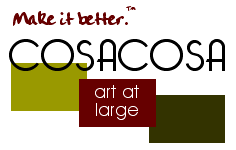



COSACOSA's Spare A Dime project was conceived on a dreary winter afternoon when we heard that the 2013 Philadelphia International Festival of the Arts (PIFA) had a time-travel theme. We were instantly intrigued. If you had a time machine, where would you go?," the PIFA information asked. And so the brainstorming began. The discussion was lively; our personal choices, diverse. Einstein's laboratory. Da Vinci's studio. The March on Washington. Socrates' farewell. An Arthurian past. A Star Trek future
But when it came down to what place and time COSACOSA (as an organization) should chose, our needs were clear: some point in history where the lessons learned would be useful to the problems we face today. We're a nonprofit serving constituents living in some of Philadelphia's most challenged neighborhoods – places where the going is tough even in times of economic prosperity. The parallels between the Great Depression and our current "Great Recession" immediately sprang to mind.
What gave hope to the hopeless during the Great Depression? How did the social safety nets we take for granted today come to be? The answer, at least in part, is the Works Progress Administration (WPA), the stimulus program of its time. Created by Presidential Order on May 6, 1935, the founding of the WPA was the perfect choice COSACOSA's moment in time.
The first sentence sung in the Spare A Dime song cycle is "life turns on a dime." Throughout the piece, we are reminded that, truly, anything can happen to anyone at any moment. How we face our losses,
how we struggle to overcome them, ultimately defines us as individuals, as communities, and as a nation.
Spare A Dime originated in stories collected from all over the city, from folks who lived through the Great Depression, from families dealing with economic hardships and devastating heartbreak today, and from the copious interviews collected by the WPA Federal Writers Project. These shared stories unite us across time and remind us that our ability to empathize with each other – to really see and listen to each other – is essential to democracy.
Recurring characters emerged from our collected stories, grounded in experiences that are almost American archetypes. Facing eviction, a mother protects her child from the harsh reality to come. Hoping for a better life, an immigrant fights discrimination. Returning from dedicated service to his country, a veteran struggles to find a job. Spare A Dime’s songs, audio recordings, photography, and animations tell six such prototypical American stories of life before and after the WPA, anchored by President Franklin Delano Roosevelt (FDR) and portions of his greatest speeches set to music. A Chorus of Liberty punctuates the song cycle in celebration the (sometimes unattainable) American dream.
Within most of COSACOSA's communities, the effects of the economic downturn are particularly pronounced. Cross-generational interviews describing perseverance and overcoming obstacles unite our young people with their elders in working for the advancement of city neighborhoods. Like the WPA, storytelling lets people know they’re not alone. Itgives them hope. America is by definition a hopeful country, a country of hopefuls. As FDR wrote in his 1940 Dayton, Ohio Address “We have always held to the hope, the belief, the conviction that there is a better life, a better world, beyond the horizon."
Kimberly Niemela is Founder and Director of COSACOSA and composer of the Spare A Dime song cycle. Her public art designs have won numerous awards and are featured internationally in the series Designing the World's Best Children's Hospitals. As an interdisciplinary artist working in sound, poetry, visual art, and film, she has received grants from the Pennsylvania Council on the Arts and the National Endowment for the Arts/AFI Media Arts Fellowship. Niemela is a consultant to community-based programs nationwide. She holds degrees in music from the University of Pennsylvania and in chemistry from Carnegie Mellon University.
Artolatry bread image after Salvadore Dalí's Basket of Bread (1926).